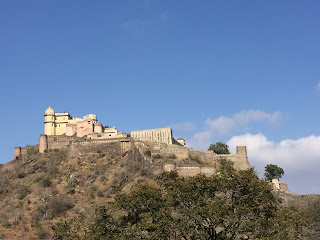Kumbhalgarh Fort is magnificent, standing on its wall fearful, and watching its boundary wall wading through hills of Mewar jaw dropping….…
After visiting the Great Wall of China in 2006 and later
knowing that second longest wall exists in my own country, India at Kumbhalgarh
(Rajasthan), it was my wish to visit this place.
And this wish has come true in December 2021. So, we reached
Kumbhalgarh from Ajmer, about 220 km by road. Kumbhalgarh is in Mewar, westerly
range of Aravali hills in Rajsamand district of Rajasthan. It is about 50 km
from Udaipur. It is the most elaborate and grand fort built by Rana Kumbha in the
15th century and has served to guard kings of the region in the most
difficult times. Probably, fort was buiIt earlier, but not its present form. It
is also a birth place of Maharana Pratap, legendary king of Rajasthan who
fought with Mughal king, Akbar in the 16th century. Reportedly, this
battle was inconclusive, but now believed to be won by Maharana Pratap of Mewar.
It has temples devoted to Vedi, Brahma-Vishnu-Mahesh. There appears to be more of
Jainism during that period. The fort is surrounded by the tall boundary wall,
about 33 km in length and is reportedly the second longest after the Great wall
of China. This fort is UNESCO heritage site.
It is pleasure driving through villages and some forests towards Kumbhalgarh and afterwards. On the way, we saw some fruit trees like sitaphal (custard apple), guava, mango, neem on both sides of road. Sitaphal was in its fading fruiting season and we picked some and found them sweet.
After we reached hotel in Kumbhalgarh, we went to see
Kumbhalgarh fort. Although entrance of fort was small relative to grand size of
its wall, fort looked magnificent. At first, we turned right to see expanse of
the boundary wall which was at least 2-metre wide and waded through hilly
terrain. On this side, there are some temples and water bodies. It is
relatively flat low laying area relatively to fort’s residential and palatial
quarters at the hill top.
The fort is well maintained, with some shops and basic facilities
for the visitors. There is light and sound programme too which is suspended due
to Covid-19 pandemic.
Later, I climbed up the fort on the left side of entrance.
There were at least four or five gates called pol, Halla pol, etc etc. As I
climbed last of top flours, I felt grasping for breath. The top presented
magnificent view of fort as well as mountains and valleys. There is small quarter
where Maharana Pratap was born. This room remains locked except on the date of this
birth when there are some celebrations. Being the month of December, it was pleasant,
as I sweated during this climb. Terrace where I and others climbed was in two
parts joined together through two-foot walkaway over the single stone wall.
Both parts had a top part of domes (ghumats).
During climb, there was a collection of artillery (5-6 tofs)
on one of the floors. I wonder as to how these were all brought up to defend
the fort. There is small temple of goddess, probably aajmata or hingalaj mata on
the top floor, which is worshipped even today.
There was none of architecture but sheer size of fort in
stones and tall gates showed magnificence of the king lording over the fort and
his kingdom.
I climbed down counting steps as many as 50 in the staircase
followed by baby walk of about 1100-1200 steps. It took all about 15-20 minutes
to come down.
We came down, visited briefly adventure park and then back
to hotel. We had a dinner, relatively reasonably priced. We slept. Room was
cosy, with duvet but not room heater. It was quite chilly, cold, probably less
than 6-7 oC.
Next day, we left for Nathdwara (gateway for God), temple of
Krishna, the deity in its 7-year old infant incarnation, shifted from Mathura (in UP) to this location in 1672 and worshipped mostly by Jains and Hindus of Gujarat
and Maharashtra.











Comments
Post a Comment